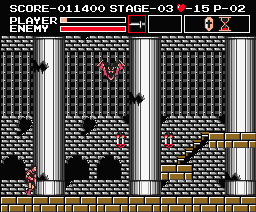Retro Replay Review
Gameplay
Vampire Killer reinvents the classic Castlevania formula by blending action-platforming with a strong emphasis on exploration and item management. Instead of moving linearly from left to right, each of the 18 stages is designed as a labyrinthine castle corridor, complete with hidden passages and destructible walls. Your primary objective in each area is to locate a white key that opens the exit door—often tucked away behind breakable blocks or concealed alcoves—before proceeding to the next level.
(HEY YOU!! We hope you enjoy! We try not to run ads. So basically, this is a very expensive hobby running this site. Please consider joining us for updates, forums, and more. Network w/ us to make some cash or friends while retro gaming, and you can win some free retro games for posting. Okay, carry on 👍)
Resource management plays a crucial role. Hearts function both as ammunition for secondary weapons (like Holy Water and Hourglass) and as currency for purchasing upgrades and items from the Old Crone. Players must decide whether to spend hearts on an immediate advantage—such as more Holy Water to clear out tougher enemies—or save them for essential tools like the map or a Yellow Key to unlock valuable chests. This tension builds a layer of strategic planning often absent in straight platformers.
Throughout each stage, you can discover a wide variety of power-ups. Whipping candles and subduing enemies yields hearts and occasionally reveals hidden items. Blue Crystals grant temporary invisibility, Sapphire Rings bestow brief invincibility, and Gold or Silver Crosses can wipe out or freeze foes entirely. These super-weapons are thrilling to find but typically offer only short-lived benefits, encouraging players to continue exploring for more sustainable upgrades like whip enhancements or speed-boosting Boots.
Boss encounters at the end of each stage require both reflexes and pattern recognition. While the standard enemies keep you on your toes with erratic movements and projectile attacks, the stage bosses demand careful timing and efficient use of sub-weapons. Defeating Dracula on stage 18 brings you face-to-face with a second, more formidable evil—testing everything you’ve learned about resource conservation, platforming precision, and sub-weapon timing before you can finally restore peace to Dransylvania.
Graphics
For a mid-1980s release on the MSX platform, Vampire Killer’s visuals are surprisingly detailed and atmospheric. The castle interior is rendered in muted grays and browns, evoking a gothic horror vibe that complements the game’s supernatural theme. Sprites for enemies such as skeletons, bats, and demonic knights are pixelated but distinct, ensuring you can identify threats quickly even in the heat of battle.
Backgrounds feature ornate stonework, flickering torches, and hidden alcoves that hint at the secrets lying behind breakable walls. Although the color palette is limited compared to later 8-bit titles, the developers use contrast effectively: white keys glow subtly in dark corners, and power-up sprites stand out against shadowy backdrops. This visual clarity is essential when searching every nook and cranny for that crucial exit key.
Animation is serviceable but not groundbreaking. Simon’s whip strike has a satisfying arc, and each sub-weapon—be it a throwing dagger or an animated cross—carries its own visual flair. Enemy movements can feel rigid by modern standards, yet they remain readable, allowing for fair gameplay. Occasional frame drops in more crowded screens are a small price to pay for the sense of scale and density in some of the larger castle rooms.
Stage transitions are quick, with minimal loading time between areas, maintaining the game’s brisk pace. In addition, the map item, when used, overlays a simple schematic that shows your current location, which is a welcome graphical aid for players navigating complex level designs. Overall, Vampire Killer’s graphics strike a balance between functional clarity and gothic ambiance.
Story
Vampire Killer casts you as young Simon Belmont on a mission to rid Dransylvania of Dracula’s evil influence. The narrative is lean but effective, relying on classic horror tropes—haunted castles, fiendish minions, and supernatural artifacts—to set the mood. There’s little in the way of dialogue or cutscenes, but the premise is clear: penetrate Dracula’s lair, defeat the vampire lord, then face the hidden malevolence driving the chaos.
Each stage represents a different segment of Dracula’s sprawling castle, from candle-lit vestibules to cryptic catacombs and forbidding towers. The minimal storytelling leaves much to the imagination, encouraging players to project their own sense of dread onto the silent corridors. This sparseness works in the game’s favor, creating a feeling of isolation and constant peril as you press onward alone with only your whip and sub-weapons for comfort.
The final confrontation with Dracula—and the subsequent reveal of a greater evil—adds a satisfying narrative twist, reminding players that true darkness often lurks behind familiar foes. While the story doesn’t evolve dramatically over the course of 18 levels, the consistent buildup of tension and the gradual reveal of more powerful enemies keep the stakes high.
For modern gamers accustomed to cinematic epics, Vampire Killer’s storyline may seem skeletal. However, its straightforward “hero versus evil” setup has a timeless appeal, especially when tied to the atmospheric level design and the witches’ workshop where you can upgrade your arsenal. The result is an old-school horror-fantasy adventure that prioritizes gameplay tension over narrative complexity.
Overall Experience
Vampire Killer delivers a challenging yet rewarding journey for fans of classic action-adventure titles. The balance between exploration and combat keeps each run fresh—no two players will uncover the castle’s secrets in the exact same way. The key-hunting mechanic ensures that you’re constantly examining every wall, floor tile, and torch flame for hidden entrances, making the game’s pacing both deliberate and engaging.
Difficulty spikes can occur, particularly in later stages where enemies swarm and the scarcity of hearts forces tough choices between offense and currency. This might frustrate casual players, but perseverance yields a strong sense of accomplishment. The wealth of sub-weapons and items—even the deceptive Red and White Books that alter shop prices—adds depth that extends beyond a single playthrough.
Audio design is minimalistic: looping chiptune tracks play over each stage, establishing a haunting mood without growing overly repetitive. Sound effects for whipping candles and collecting hearts are crunchy and satisfying, reinforcing the tactile feel of every action. While the MSX hardware limits the scope of audio fidelity, Vampire Killer makes the most of its available channels.
Ultimately, Vampire Killer stands out as an early experiment in non-linear platforming, blending tight action with exploration-based level design. Its unique key-and-item focus distinguishes it from its American Castlevania counterpart, offering a compelling challenge for retro enthusiasts and newcomers curious about gaming history. If you appreciate methodical exploration, resource management, and old-school difficulty, this gothic romp through Dransylvania is well worth your time.
 Retro Replay Retro Replay gaming reviews, news, emulation, geek stuff and more!
Retro Replay Retro Replay gaming reviews, news, emulation, geek stuff and more!









Reviews
There are no reviews yet.